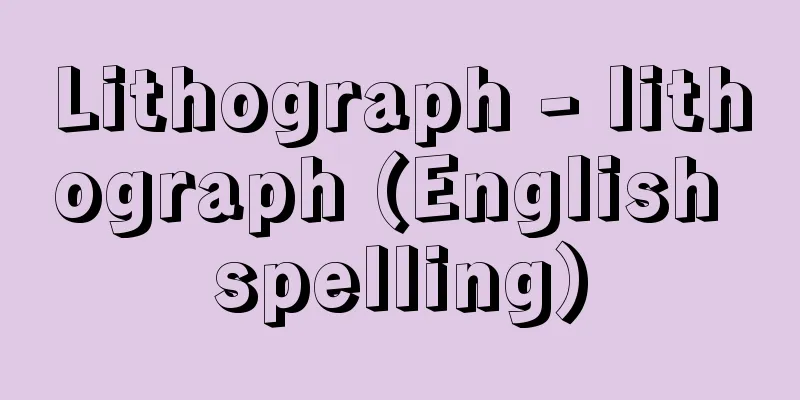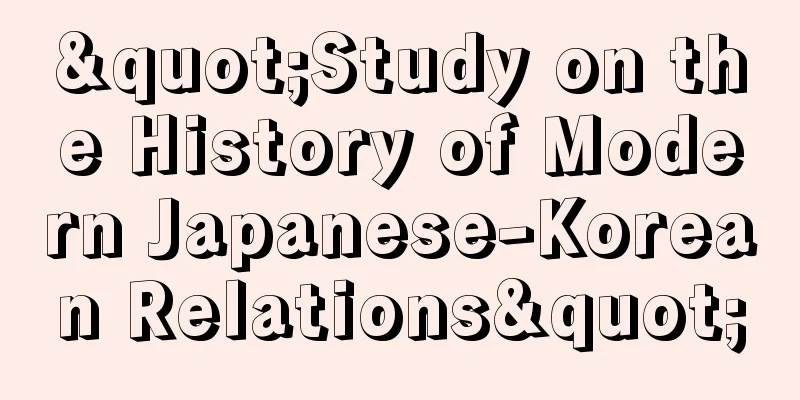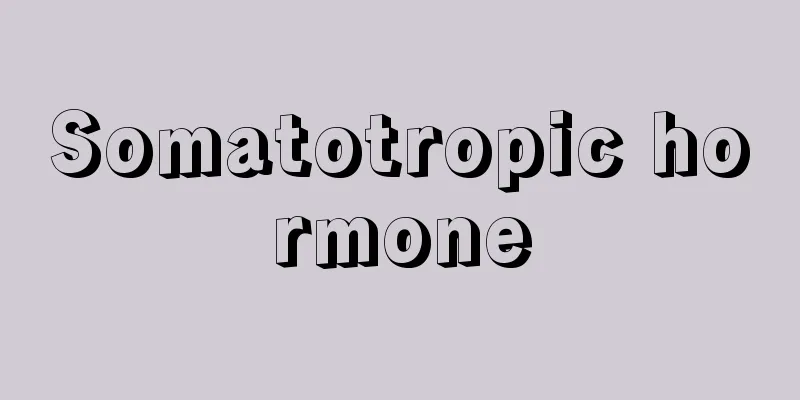Lithograph - lithograph (English spelling)

|
It is thought to be a misreading of the English word lithograph, but it is also called lithography. It is a printing technique (planographic method) that uses the repulsive properties of water and oil to print without creating unevenness on the plate surface, and the works produced using it. The name is derived from the Greek word lithos (meaning stone) because limestone is used. [Haruki Yaegashi] techniqueThe surface of limestone (it is considered the best quality to be from Bavaria, Germany) is polished to make it smooth, and then drawings are made on it with oil-based crayons or oil-based ink. When a gum arabic solution, made by adding a small amount of nitric acid to a gum arabic solution, is applied to the surface, the oil-based parts of the drawing turn into calcium fatty acids, and the other parts are covered with a film of gum arabic. When water is applied to this, the drawing repels the water, and the parts covered with gum arabic retain the moisture. When oil-based ink is then applied on top of this with a roller or similar, the oleophilic parts of the drawing retain it, and the other parts that contain moisture do not accept the ink. The work is printed by placing a sheet of paper face down on this plate and applying pressure. A multi-color lithograph requires as many plates as there are colors, and professionally, an additional process of adjusting the plate surface is added at the platemaking stage. As mentioned above, it is possible to draw directly on the lithograph, but since this method was initially developed for the purpose of printing music scores and pamphlets rather than artworks, the transfer method was invented to overcome the inconvenience of drawing a rough sketch that is upside down from the desired result. This method involves drawing with oil-based crayons or ink on transfer paper (Japanese paper coated with starch), placing it face down on the lithograph, applying water from above, and transferring the original image on the transfer paper to the plate by applying pressure, thereby obtaining a printed result with the same orientation as the original. This method was improved in the 1850s by the French Auguste Burri and Joseph Lemercier (1803-1887) and made it commercially practical. In lithography, the transfer and printing are usually left to specialized craftsmen. Lithographs can be reused if the surface is polished again, but because good quality limestone is expensive and difficult to handle, a method of using zinc plates as an alternative was developed early on, and they were used almost exclusively for cheap prints and commercial printing. With zinc plates, an etching solution made from gum arabic solution mixed with phosphoric acid or tannic acid is used instead of rubber nitric acid solution. This method has also been improved, and today most prints known as lithographs use zinc plates. Additionally, offset printing, which came into practical use in the early 20th century, also applies the principles of the zinc transfer plate method. [Haruki Yaegashi] historyWesternLithography was invented in 1796 by Munich actor and director Alois Senefelder. He used it to publish his own scripts at low cost, and in 1798 he also invented the transfer method. His "Lithography" was published in Munich in 1818, and by this time lithography had spread to France and England, where it had developed considerably in terms of technique and expression. Because of its ability to reproduce almost exactly the effects of pencil, pen, and brush drawings, many artists produced works with it even before the 19th century. It is also possible to create unique effects by drawing or transferring onto the plate and then partially scraping it off with a needle or scraper. Printmakers who excelled in this method include the French Henri Fantin-Latour and the German Adolph von Menzel (1815-1905). Lithography flourished in France from the 1820s onwards, and it is said that it was "invented in Germany and became an art in France." In 1828, Romantic painters such as Delacroix (including the Faust series) and Géricault produced a succession of excellent works. It was also in 1825 that Goya, who was in exile in Bordeaux, produced his magnificent series "The Bullfight in Bordeaux." The social painter Daumier published scathing social and political criticisms mainly in satirical magazines such as Caricature and Charivari from 1832 to 1872, and these works were also produced using lithographs, totalling some 4,000 pieces. This printing technique was also widely used for reporting and record-keeping, and the heroic depictions of Napoleon's military history by Nicolas Toussaint Charlet (1792-1845) and Auguste Raffet (1804-1860) were enthusiastically received by the French people. It also showed signs of surpassing earlier copperplate printing as a means of illustrating natural science books and printing topographical landscapes. In the second half of the 19th century, most artists turned to lithography, and artists such as Chassériau, Rodolphe Bresdin (1822/1825-1885), Manet, Degas, Fantin-Latour, Redon, Toulouse-Lautrec, and Gauguin all captivated enthusiasts with their unique styles. Outside of France, Whistler and the German Menzel made brilliant achievements in the history of lithography. Color lithography was invented in the mid-1830s by the German Godefroy Engelmann, who used a method of overprinting with plates of the three primary colors. However, due to difficulties in producing colors, it did not become common as a method for creative printmaking, although it was fine for reproducing paintings. In the late 1880s, the Frenchman Jules Cheret, influenced by Japanese ukiyo-e prints, began producing large posters for theaters, cabarets, etc., using a method that effectively contrasted limited colored surfaces rather than realistic reproduction. This method quickly had a major impact on both creative printmaking by artists and advertising art, and it went hand in hand with the international Art Nouveau craze at the end of the century. Printmakers who produced excellent works using color lithography include Toulouse-Lautrec, Maurice Denis, Bonnard, and Vuillard. Renoir and Cézanne also left behind fascinating color prints. Meanwhile, professional poster artists such as Eugène Grasset (1845-1917) and Mucha also appeared. Art dealers such as Ambroise Vollard (1866-1939) commissioned artists to publish collections of prints and illustrated books, which became popular at the end of the 19th century and continues to this day. Outside of France, the Norwegian painter Munch produced works with strong expressionist tendencies using lithography as well as woodblock prints. In Germany, after the magazine Pan introduced the aforementioned French works at the end of the 19th century, painters such as Max Liebermann, Max Slevogt (1868-1932), and Lowis Corinth, as well as the satirical illustrator Thomas Theodor Heine (1867-1948), were active in using this technique, but in the 20th century, Expressionist painters such as Kirchner and Nolde took over this style. In the 20th century, especially after World War I, printmaking experienced unprecedented prosperity, with a great number of painters and professional printmakers producing a huge number of works using a wide variety of techniques. Artists who were particularly active in the field of lithography include Picasso, Braque, Miro, Klee, Kandinsky, Chagall, and Dali. [Haruki Yaegashi] JapanLithography was introduced to Japan in the late Edo period, when Kawahara Keiga and Utagawa Kuniyoshi are known to have copied European lithographs, but it was not until the end of the Edo period that prints were produced in Japan using this technique. In 1860 (Man'en 1), a Prussian envoy presented a lithograph printing press to the shogunate, but this machine was not used for actual production; rather, lithography began with Christian missionary activities in Nagasaki, Yokohama, and Hakodate, and the publication of early newspapers by Europeans. In the Meiji period, lithography took root in Japan through research into lithography techniques for identifying counterfeit banknotes by the Ministry of Finance's Paper Money Bureau (later the Printing Bureau), and its use in the publication of textbooks by the military and the Ministry of Education. Umemura Suizan (1839-1906), who retired from the Paper Money Bureau, established a private workshop called the "Engraving Company" and invited both Skilick and Pollard from the United States to train Japanese craftsmen. Matsuda Rokuzan (Matsuda Atsutomo), also a former Paper Money Bureau employee, opened "Gengendo", where he gathered Western-style painters and conducted lithograph production in the form of an art school, paving the way for the popularity of single-sheet lithographs for appreciation. As a result of these private activities, lithographs came to be widely used for illustrations in magazines and books, commercial printing, and other purposes in the 1870s, while single-sheet lithographs known as "framed pictures" also reached their heyday between 1887 and 1892 (Meiji 20-25). After that, lithography was used more prominently in commercial printing, but artistic lithographs were also produced. Representative artists include Ishii Hakutei, Yamamoto Kanae, Morita Tsunetomo and other members of the "Hosun" magazine in the Meiji period, Oda Kazuma and Hazama Inosuke in the Taisho and Showa periods, and Varvara Dmitrievna Bubnova (1886-1983), a Russian woman who lived in Japan from 1922 (Taisho 11) to 1959 (Showa 34). After the Second World War, the worldwide boom in printmaking hit Japan, and many printmakers produced works using lithography, but serigraphy (a type of screen printing) seems to be more commonly used for color printmaking. There are also many artists who combine lithography with serigraphy, etching, mezzotint, and woodblock printing. Today's artists who have produced fascinating works using lithography include Kano Mitsuo (1933-), Kimura Kosuke (1936-), Hara Takeshi (1942-), Arakawa Shusaku, Tsukasa Osamu (1936-), and Kitagawa Tamiji. Koiso Ryohei is also an artist who used the effects of pencil sketches in his prints. [Haruki Yaegashi] "Lithography - Drawing, Platemaking, Printing, Combined Plates, etc." by Hideo Yoshihara (1972, Bijutsu Shuppansha) " "Lithography - 200 Years of History and Techniques" edited by D. Porzio and supervised by Seiji Maekawa (1985, Shogakukan) [References] | | | | |"The Bullring Divided", 1825 Lithograph, Collection of the Art Institute of Chicago "> Goya's "The Bullfight in Bordeaux" 1834 Lithograph ( Collection of the Metropolitan Museum of Art ) Daumier's "The Rue Transnonant, 1834" 1879 Lithograph ( Collection of the Art Institute of Chicago ) Redon: Visions in a Dream 1891 Lithograph ( Collection of the Art Institute of Chicago ) Toulouse-Lautrec's "Moulin Rouge, La..." Poster depicting actress Sarah Bernhardt. Lithograph, 1896. Paris Musées . Mucha's "La Traviata" Source: Shogakukan Encyclopedia Nipponica About Encyclopedia Nipponica Information | Legend |
|
英語のリソグラフの誤読から生じたことばと思われるが、石版画(せきばんが)ともいう。版面に凹凸を形成することなく、水と油の反発しあう性質を利用して印刷する版画の技法(平版(へいはん)法)、およびその作品。石灰石を用いることから、ギリシア語のlithos(石の意)をもとにこの名が与えられた。 [八重樫春樹] 技法石灰石(ドイツ、バイエルン州産のものがもっとも良質とされる)の表面を研磨して平滑にし、その上に油性クレヨンまたは油性インキで描画する。その表面にアラビアゴム溶液に少量の硝酸を加えた硝酸ゴム液を塗布すると、油脂質の描画部分は脂肪酸カルシウムに変わり、他の部分はアラビアゴムの膜で覆われる。これに水を与えると、描画部分は水をはじき、アラビアゴムで覆われた部分は水分を保持する。さらにその上から油性のインキをローラーなどで与えると、親油性の描画部分はこれを保持し、水分を含んだ他の部分はインキを受け付けない。作品は、この原版に用紙を伏せてのせ、圧力を加えて刷り取る。多色刷りのリトグラフは色の数だけの原版を必要とするが、専門的には製版の段階でさらに版面調整の工程が加わる。 以上のように直接石版面に描画することもできるが、この方法は当初美術作品よりも楽譜やパンフレットの印刷を目的として開発されたため、求める結果とは左右逆の下絵を描く不便を克服する必要から転写法が考案された。これは、転写紙(和紙にデンプン質を塗布したもの)に油脂質のクレヨンやインキで描画し、それを石版面に伏せて上から水を与え、圧力をかけて転写紙上の原画を版面に転写する方法で、これによって原画と同じ向きの印刷結果を得ることができる。そしてこの方法は、1850年代にフランスのオーギュスト・ブリとジョゼフ・ルメルシエJoseph Lemercier(1803―1887)の改良によって商業的実用化が可能になった。リトグラフでは、転写や印刷は専門の職人に任せるのが普通である。 石版は表面を研磨し直せば再使用できるが、良質の石灰石は高価でしかも扱いがむずかしいので、亜鉛版を代用する方法が早くから開発され、安手の版画や商業印刷物などはもっぱらこれで行われた。亜鉛版の場合は硝酸ゴム液のかわりに、アラビアゴム溶液にリン酸あるいはタンニン酸などを加えたエッチング液を用いる。この方法も改良が進み、今日ではリトグラフとよばれる版画のほとんどは亜鉛版が使用されている。また、20世紀初頭から実用化されたオフセット印刷も、転写法亜鉛版の原理を応用したものである。 [八重樫春樹] 歴史西洋リトグラフは1796年、ミュンヘンの俳優で演出家のアロイス・ゼーネフェルダーによって考案された。彼は自作の脚本を廉価に出版するためにこれを使用し、さらに1798年には転写法をも発明した。彼の『石版印刷教本』は1818年にミュンヘンで刊行されたが、このころになるとフランス、イギリスにもリトグラフは伝播(でんぱ)し、技術的・表現的にもかなりの発達をみた。鉛筆、ペン、筆などの素描の効果をほぼそのままに再現できる特質をもつことから、19世紀以前にも多くの画家が作品を制作している。また版面に描画あるいは転写したうえ、それを針やスクレーパーで部分的に削り取ることで独特の効果を生み出すこともできる。この方法を得意とした版画家には、フランスのアンリ・ファンタン・ラトゥール、ドイツのアドルフ・メンツェルAdolph von Menzel(1815―1905)らがいる。 1820年代以降、リトグラフは「ドイツで発明され、フランスで芸術となった」といわれるようにフランスでの隆盛が目覚ましく、1828年にはドラクロワ(『ファウスト』の連作など)、ジェリコーらロマン主義の画家たちが次々に優れた作品を生み出した。またボルドーに亡命していたゴヤが『ボルドーの闘牛』のみごとな連作をつくったのも1825年のことである。社会派の画家ドーミエは1832~1872年に『カリカチュール』や『シャリバリ』などの風刺雑誌を中心に痛烈な社会・政治批判を行ったが、これもリトグラフによるもので、その数は4000点にも達する。この版画技法は報道や記録などにも盛んに活用され、ニコラ・トゥサン・シャルレNicolas Toussaint Charlet(1792―1845)やオーギュスト・ラフェAuguste Raffet(1804―1860)がナポレオンの戦歴を英雄的に描いたものはフランス国民に熱狂的に迎えられ、また自然科学書の挿絵や地誌的な風景版画の手段として、従前の銅版画をしのぐ勢いをみせた。 19世紀後半になるとほとんどの画家がリトグラフに手を染め、シャッセリオ、ブレダンRodolphe Bresdin(1822/1825―1885)、マネ、ドガ、ファンタン・ラトゥール、ルドン、トゥールーズ・ロートレック、ゴーギャンらがそれぞれ独特の表現で愛好家を魅了した。また、フランス以外ではホイッスラー、ドイツ人のメンツェルらがリトグラフ史上に輝かしい業績を印した。 カラー・リトグラフは、1830年代のなかばにドイツ人のゴデフロイ・エンゲルマンによって三原色の版による重ね刷りの方法が考案されたが、発色に難があり、絵画の複製手段としてはともかく、創作版画の方法としては一般化しなかった。1880年代の末にフランスのジュール・シェレが日本の浮世絵などの影響のもとに、写実的な再現ではなく限られた色彩の面を効果的に対比させる手法で、劇場、キャバレーなどの大型ポスターの制作を始めた。この方法はたちまち画家による創作版画と広告芸術の両面に多大な影響を与えたが、これは世紀末の国際的なアール・ヌーボーの流行と相携えていた。このようなカラー・リトグラフによる優れた作品を生んだ版画家としては、トゥールーズ・ロートレック、モーリス・ドニ、ボナール、ビュイヤールがあげられる。また、ルノワールとセザンヌも魅力的な色彩版画を残している。一方ウージェーヌ・グラッセEugène Grasset(1845―1917)やミュシャらの専門のポスター作家も現れた。アンブロワーズ・ボラールAmbroise Vollard(1866―1939)らの画商が画家に依頼して版画集や挿絵入り本を刊行することが、19世紀末から流行し、今日に至っている。 フランス以外では、ノルウェーの画家ムンクが木版画とともにリトグラフによって表現主義的傾向の強い作品を生んだ。またドイツでは世紀末に雑誌『パン』が前記のフランスの作品を紹介してから、マックス・リーバーマン、マックス・シュレフォークトMax Slevogt(1868―1932)、ロウィス・コリントらの画家たちや風刺挿絵画家のハイネThomas Theodor Heine(1867―1948)らがこの技法を用いて活躍したが、20世紀に入るとキルヒナーやノルデをはじめ表現主義の画家たちがこれを受け継いだ。 20世紀も、とりわけ第一次世界大戦以降は版画芸術が未曽有(みぞう)の繁栄を迎え、非常に多くの画家や専門の版画家が多彩な技法を用いて膨大な数の作品を生み出したが、リトグラフの分野で出色の活躍をした作家としては、ピカソ、ブラック、ミロ、クレー、カンディンスキー、シャガール、ダリなどがあげられよう。 [八重樫春樹] 日本日本へのリトグラフの伝来は江戸時代後期で、川原慶賀(かわはらけいが)や歌川国芳(くによし)らがヨーロッパの石版画を模写したことが知られているが、この技法によって日本で版画が制作されるのは幕末になってからであった。1860年(万延1)プロシア使節が石版印刷機を幕府に献上しているが、実際の制作はこの機械によるものではなく、長崎、横浜、函館(はこだて)でのキリスト教布教活動やヨーロッパ人による初期新聞の刊行がその始まりであった。明治に入ると、大蔵省紙幣寮(のちの印刷局)の偽造紙幣鑑識のための石版技術の研究、軍部や文部省の教科書出版への利用などによって、リトグラフは日本に根を下ろしていった。紙幣寮を引退した梅村翠山(すいざん)(1839―1906)は民間の工房「彫刻会社」を設立し、アメリカからスキリック、ポラードの両者を招いて日本人職人の指導にあたらせた。同じく紙幣寮出身の松田緑山(ろくざん)(松田敦朝(あつとも))も「玄々堂」を開設し、洋画家を集めて画塾の形式をとりながら石版画の制作を進め、鑑賞用一枚刷り石版画流行の基を開いた。こうした民間の活動により、明治10年代にはリトグラフは雑誌や書籍の挿絵、商業印刷物などに幅広く活用され、一方、1887~1892年(明治20~25)には「額絵」と称する一枚刷り石版画も全盛を迎えた。 その後、リトグラフはむしろ商業印刷物の分野での活用が目覚ましかったが、芸術的な石版画も制作された。その代表的作家としては、明治の石井柏亭(はくてい)、山本鼎(かなえ)、森田恒友(つねとも)ら『方寸(ほうすん)』の同人、大正・昭和期では織田一磨(かずま)、硲(はざま)伊之助、また1922年(大正11)から1959年(昭和34)にかけて滞日したロシア人のブブノワ夫人Varvara Dmitrievna Bubnova(1886―1983)などがあげられる。 第二次世界大戦後、世界的な版画ブームは日本にも訪れ、リトグラフによって制作をする版画家も少なくないが、色彩版画としてはセリグラフィ(孔版(こうはん)の一種シルクスクリーン)のほうが多用されているようである。またリトグラフとセリグラフィ、エッチング、メゾチント、木版を併用する作家も少なくない。リトグラフによって魅力的な作品を生んだ今日の作家としては、加納光於(みつお)(1933― )、木村光佑(こうすけ)(1936― )、原健(たけし)(1942― )、荒川修作、司修(つかさおさむ)(1936― )、北川民次(たみじ)などがいる。また鉛筆素描の効果を版画に生かした画家として小磯良平(こいそりょうへい)があげられる。 [八重樫春樹] 『吉原英雄著『リトグラフ――描画・製版・刷り・併用版他』(1972・美術出版社)』▽『D・ポルツィオ編、前川誠郎監修『リトグラフ――200年の歴史と技法』(1985・小学館)』 [参照項目] | | | | |「二分された闘牛場」 1825年 リトグラフシカゴ美術研究所所蔵"> ゴヤ『ボルドーの闘牛』 1834年 リトグラフメトロポリタン美術館所蔵"> ドーミエ『トランスノナン街 1834年… 1879年 リトグラフシカゴ美術研究所所蔵"> ルドン『夢の中で 幻視』 1891年 リトグラフシカゴ美術研究所所蔵"> ロートレック『ムーラン・ルージュ、ラ・… 女優サラ・ベルナールを描いたポスター。1896年 リトグラフParisMusées"> ミュシャ『椿姫』 出典 小学館 日本大百科全書(ニッポニカ)日本大百科全書(ニッポニカ)について 情報 | 凡例 |
<<: Li Delin (English spelling) Lǐ Dé lín
Recommend
Eutakuta section - Eutakuta section
…The pollen does not have an air sac like the Pin...
Sanjo Munechika
Date of birth and death unknown. A swordsmith in ...
TAU
Located in Ginza, Chuo-ku, Tokyo, this is an anten...
Chahār Aimāq (English spelling)
A tribe in western Afghanistan. Its name means Cha...
Staatsoper Berlin (Ost) (English spelling) Staatsoper Berlin
…Premiere of Donizetti's Belisario. Berlin St...
Jinaimachi - Jinaimachi
An artificial town created in the first half of t...
Hinokibayadori - Hinokibayadori
A parasitic plant with degenerated leaves of the M...
Komissarov, VN (English spelling) KomissarovVN
…When translating from European languages to Ja...
Parrot Disease - Parrot Disease
An infectious disease of birds such as parrots and...
Arashi Yoshisaburo (5th generation)
…After World War II, they attracted attention for...
Dai Viet (English spelling)
The name of the country of Vietnam used from 1054 ...
Almeida, FAde (English spelling) AlmeidaFAde
…Evora was a religious center, and in the 16th ce...
Okitsu Sea Bream - Okitsudai
<br /> Sweetfish. Especially salted and drie...
Peristedion orientale (English spelling) Peristedion orientale
...There are 13 species in 4 genera known from th...
Index fossil - index fossil
Also called standard stones. A fossil that indicat...









